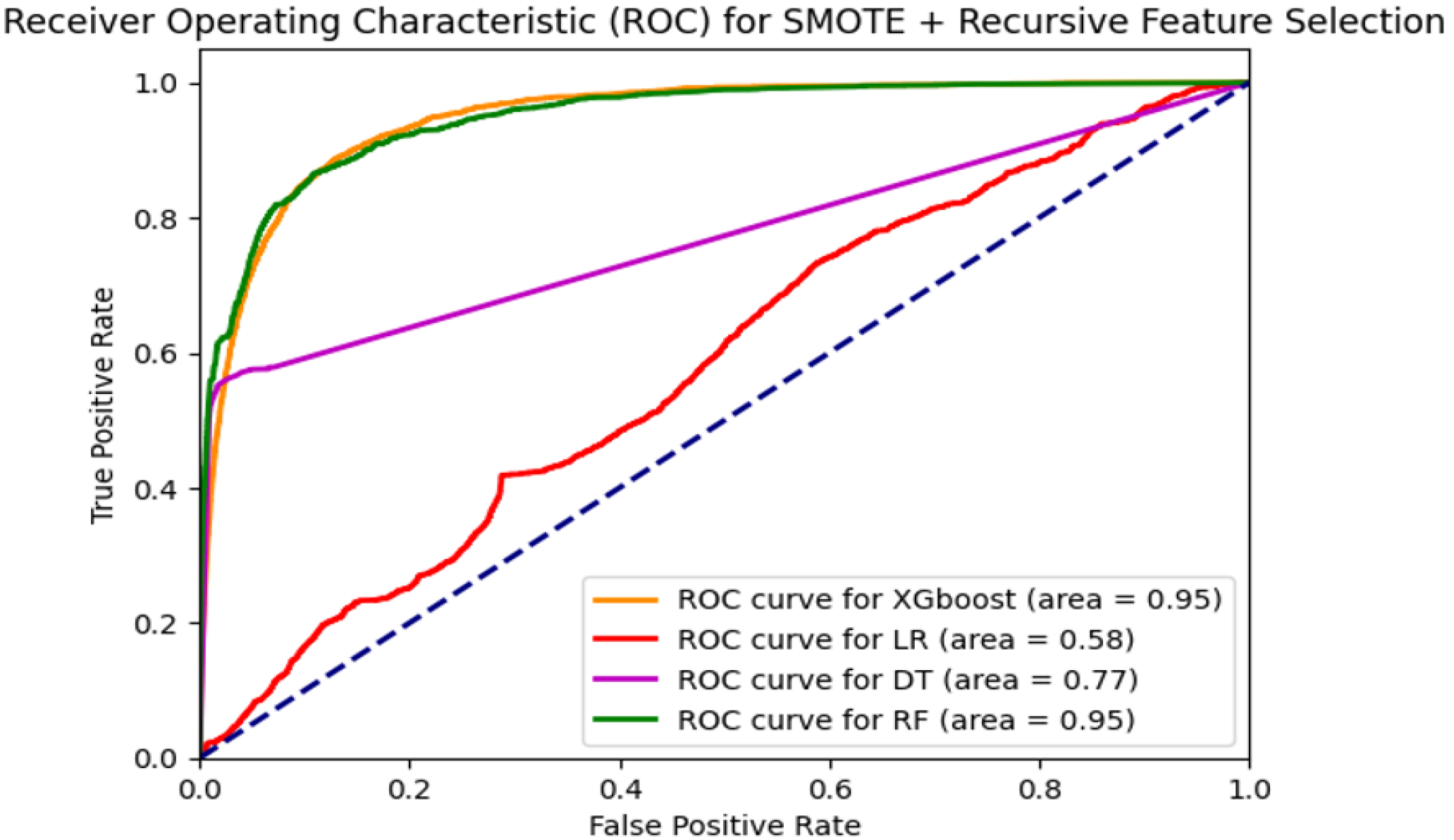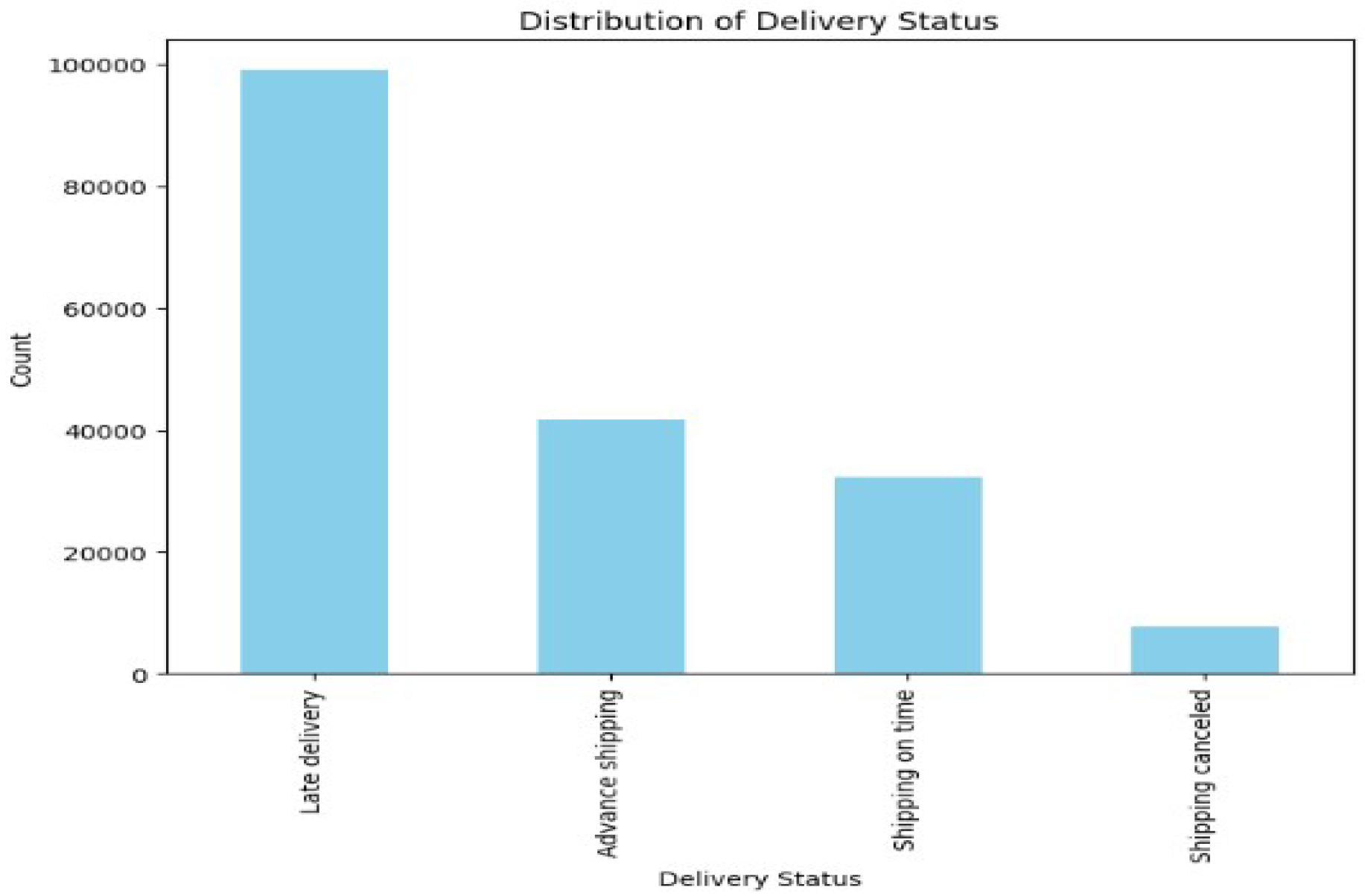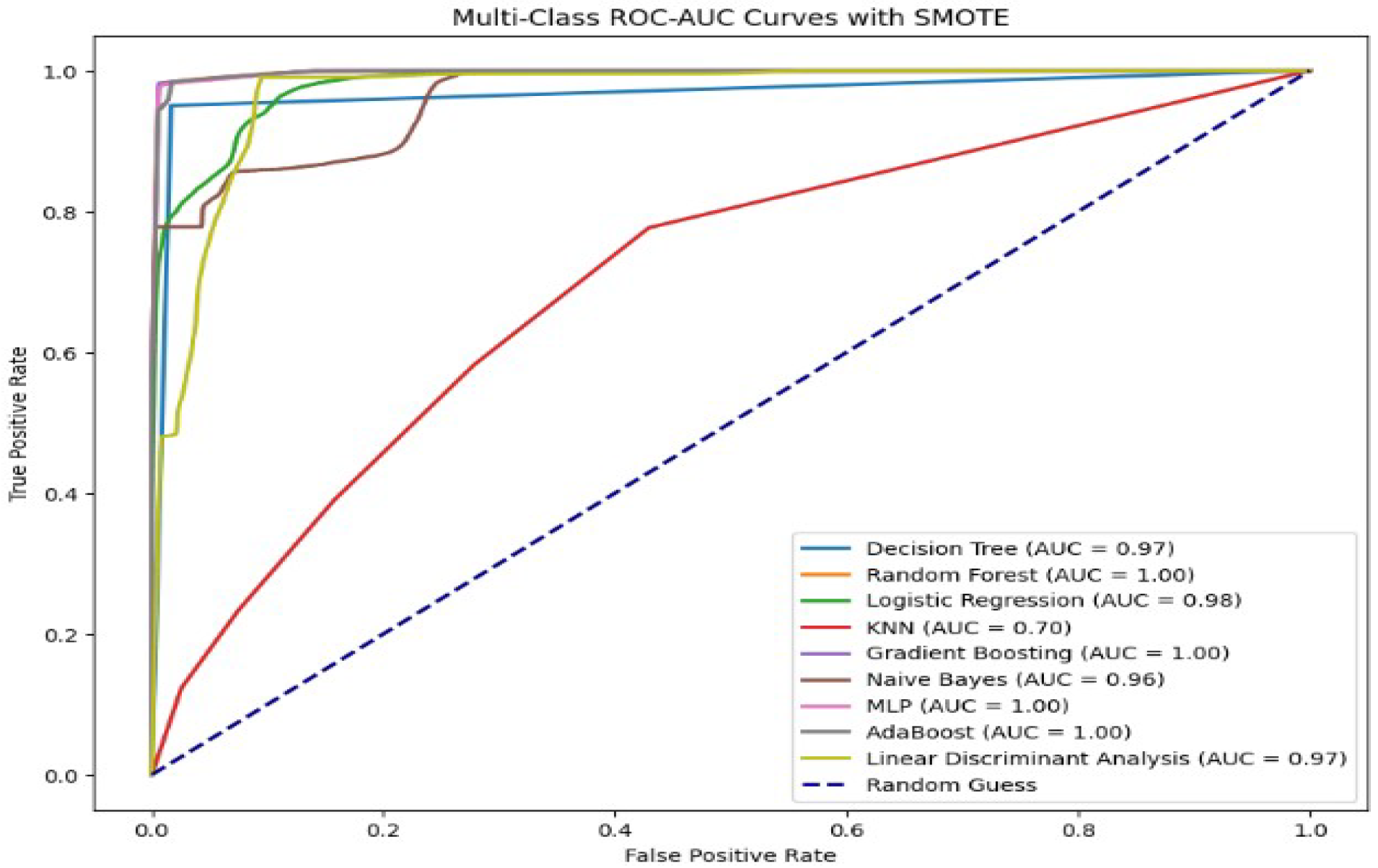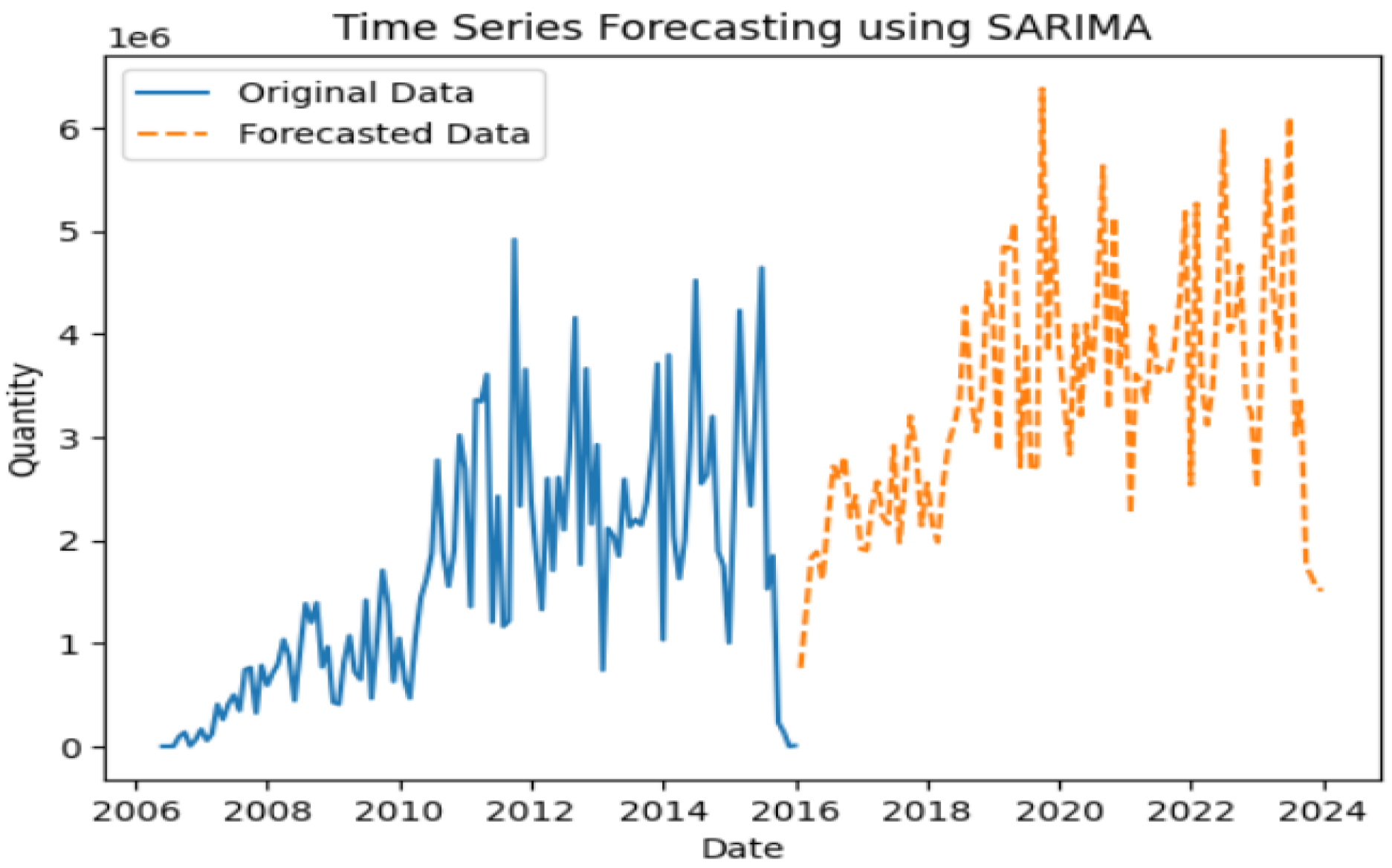Catalyzing Supply Chain Evolution: A Comprehensive Examination of Artificial Intelligence Integration in Supply Chain Management †
Abstract
1. Introduction
2. Accuracy vs. Explainability in AI for Supply Chain Management
3. Literature Survey
3.1. Genetic Algorithms in Supply Chain Optimization
3.2. Natural Language Processing (NLP) in Supply Chain Management
3.3. Time Series Forecasting for Supply-Chain Management Challenges
3.4. AI and Big Data Analytics for Supply Chain Resilience
3.5. AI’s Impact on Supply Chain Performance
3.6. AI Integration Framework in Supply Chain Management
3.7. Commonly Used AI Techniques in Supply Chain Management
3.8. AI and ML for Manufacturing Enterprise Enhancement
3.9. AI and Blockchain for Supply Chain Resilience
4. Integrating Machine Learning in Supply Chain Management
4.1. Case Study I: Back-Order Problem
Role of Machine Learning
4.2. Case Study II: Order Status Prediction
Role of Machine Learning
4.3. Case Study III: Time Series Forecasting
Role of Machine Learning
5. Conclusions
Author Contributions
Funding
Institutional Review Board Statement
Informed Consent Statement
Data Availability Statement
Acknowledgments
Conflicts of Interest
References
- Kazemi, M.; Rahimi, N. A Comprehensive Review on Forecasting Demand in Supply Chain Management. Comput. Ind. Eng. 2019, 135, 1272–1285. [Google Scholar]
- Feng, Q.; Li, X.; Liu, J.; Wang, Z.; Wang, Z. A Survey of Demand Forecasting in Fashion Retail. IEEE Trans. Ind. Inform. 2020, 17, 4471–4481. [Google Scholar]
- Li, S.; Fu, Y.; Wang, J.; Zhang, S. Optimizing the Green Supply Chain Coordination for Perishable Products under Asymmetric Information and Supply Disruption. Eur. J. Oper. Res. 2020, 283, 625–642. [Google Scholar]
- Zhang, Y.; Liu, Y.; Wan, L. Supplier Selection in Fashion Retailing: A Data-Driven Approach. IEEE Trans. Ind. Inform. 2019, 16, 6549–6558. [Google Scholar]
- Gupta, R.; Dahiya, A.; Kumar, V.; Jain, A.; Singh, P.K. Artificial Intelligence in Vision Based Quality Control: A Review. Robot. Comput.-Integr. Manuf. 2021, 69, 102228. [Google Scholar]
- Chen, J.; Shen, Z.J.M.; Wang, J. An Ensemble Learning Method for Supply Chain Disruption Prediction. Eur. J. Oper. Res. 2020, 283, 1077–1091. [Google Scholar]
- Ribeiro, M.T.; Singh, S.; Guestrin, C. “Why should I trust you?”: Explaining the predictions of any classifier. In Proceedings of the 22nd ACM SIGKDD International Conference on Knowledge Discovery and Data Mining, San Francisco, CA, USA, 13–17 August 2016; pp. 1135–1144. [Google Scholar]
- Lipton, Z.C. The Mythos of Model Interpretability. arXiv 2016, arXiv:1606.03490. [Google Scholar]
- Toorajipour, R.; Sohrabpour, V.; Nazarpour, A.; Oghazi, P.; Fischl, M. Artificial intelligence in supply chain management: A systematic literature review. J. Bus. Res. 2021, 122, 502–517. [Google Scholar] [CrossRef]
- Zamani, E.; Smyth, C.; Gupta, S.; Dennehy, D. Artificial Intelligence and Big Data Analytics for Supply Chain Resilience: A Systematic Literature Review. Ann. Oper. Res. 2022, 327, 605–632. [Google Scholar] [CrossRef] [PubMed]
- Belhadi, A.; Mani, V.; Kamble, S.; Khan, S.; Verma, S. Artificial intelligence-driven innovation for enhancing supply chain resilience and performance under the effect of supply chain dynamism: An empirical investigation. Ann. Oper. Res. 2021, 333, 627–652. [Google Scholar] [CrossRef] [PubMed]
- Hendriksen, C. Artificial intelligence for supply chain management: Disruptive innovation or innovative disruption? J. Supply Chain. Manag. 2023, 59, 65–76. [Google Scholar] [CrossRef]
- Atwani, M.; Hlyal, M.; Elalami, J. A Review of Artificial Intelligence applications in Supply Chain. ITM Web Conf. 2022, 46, 03001. [Google Scholar] [CrossRef]
- Rana, J.; Daultani, Y. Mapping the Role and Impact of Artificial Intelligence and Machine Learning Applications in Supply Chain Digital Transformation: A Bibliometric Analysis. Oper. Manag. Res. 2023, 16, 1641–1666. [Google Scholar] [CrossRef]
- Kashem, M.A.; Shamsuddoha, M.; Nasir, T.; Chowdhury, A.A. Supply Chain Disruption versus Optimization: A Review on Artificial Intelligence and Blockchain. Knowledge 2023, 3, 80–96. [Google Scholar] [CrossRef]
- Shajalal, M.; Hajek, P.; Abedin, M. Product Backorder Prediction Using Deep Neural Network on Imbalanced Data. Int. J. Prod. Res. 2021, 61, 302–319. [Google Scholar] [CrossRef]
- Hajek, P.; Abedin, M.Z. A Profit Function-Maximizing Inventory Backorder Prediction System using Big Data Analytics. IEEE Access 2020, 8, 58982–58994. [Google Scholar] [CrossRef]
- Saraogi, G.; Gupta, D.; Sharma, L.; Rana, A. An Un-Supervised Approach for Backorder Prediction Using Deep Autoencoder. Recent Adv. Comput. Sci. Commun. 2021, 14, 500–511. [Google Scholar] [CrossRef]
- Inprasit, T.; Tanachutiwat, S. Reordering Point Determination Using Machine Learning Technique for Inventory Management. In Proceedings of the International Conference on Engineering, Applied Sciences, and Technology (ICEAST), Phuket, Thailand, 4–7 July 2018; pp. 1–4. [Google Scholar]
- Chen, T.; Guestrin, C. XGBoost: A Scalable Tree Boosting System. In Proceedings of the 22nd ACM SIGKDD International Conference on Knowledge Discovery and Data Mining, KDD’16, San Francisco, CA, USA, 13–17 August 2016; Association for Computing Machinery: New York, NY, USA, 2016; pp. 785–794. [Google Scholar] [CrossRef]
- Wang, S.; Dai, Y.; Shen, J.; Xuan, J. Research on expansion and classification of imbalanced data based on SMOTE algorithm. Sci. Rep. 2021, 11, 24039. [Google Scholar] [CrossRef] [PubMed]
- Chawla, N.; Bowyer, K.; Hall, L.; Kegelmeyer, W. SMOTE: Synthetic Minority Over-sampling Technique. J. Artif. Intell. Res. (JAIR) 2002, 16, 321–357. [Google Scholar] [CrossRef]
- Permanasari, A.; Hidayah, I.; Bustoni, I.A. SARIMA (Seasonal ARIMA) implementation on time series to forecast the number of Malaria incidence. In Proceedings of the 2013 International Conference on Information Technology and Electrical Engineering (ICITEE), Yogyakarta, Indonesia, 7–8 October 2013; pp. 203–207. [Google Scholar] [CrossRef]
- Chhabra, H. A Comparative Study of ARIMA and SARIMA Models to Forecast Lockdowns Due to COVID-19 (version 1). 2022; Preprint. [Google Scholar] [CrossRef]






Disclaimer/Publisher’s Note: The statements, opinions and data contained in all publications are solely those of the individual author(s) and contributor(s) and not of MDPI and/or the editor(s). MDPI and/or the editor(s) disclaim responsibility for any injury to people or property resulting from any ideas, methods, instructions or products referred to in the content. |
© 2024 by the authors. Licensee MDPI, Basel, Switzerland. This article is an open access article distributed under the terms and conditions of the Creative Commons Attribution (CC BY) license (https://creativecommons.org/licenses/by/4.0/).
Share and Cite
Pattnaik, S.; Liew, N.; Kures, A.O.; Pinsky, E.; Park, K. Catalyzing Supply Chain Evolution: A Comprehensive Examination of Artificial Intelligence Integration in Supply Chain Management. Eng. Proc. 2024, 68, 57. https://doi.org/10.3390/engproc2024068057
Pattnaik S, Liew N, Kures AO, Pinsky E, Park K. Catalyzing Supply Chain Evolution: A Comprehensive Examination of Artificial Intelligence Integration in Supply Chain Management. Engineering Proceedings. 2024; 68(1):57. https://doi.org/10.3390/engproc2024068057
Chicago/Turabian StylePattnaik, Sarthak, Natasya Liew, Ali Ozcan Kures, Eugene Pinsky, and Kathleen Park. 2024. "Catalyzing Supply Chain Evolution: A Comprehensive Examination of Artificial Intelligence Integration in Supply Chain Management" Engineering Proceedings 68, no. 1: 57. https://doi.org/10.3390/engproc2024068057
APA StylePattnaik, S., Liew, N., Kures, A. O., Pinsky, E., & Park, K. (2024). Catalyzing Supply Chain Evolution: A Comprehensive Examination of Artificial Intelligence Integration in Supply Chain Management. Engineering Proceedings, 68(1), 57. https://doi.org/10.3390/engproc2024068057





